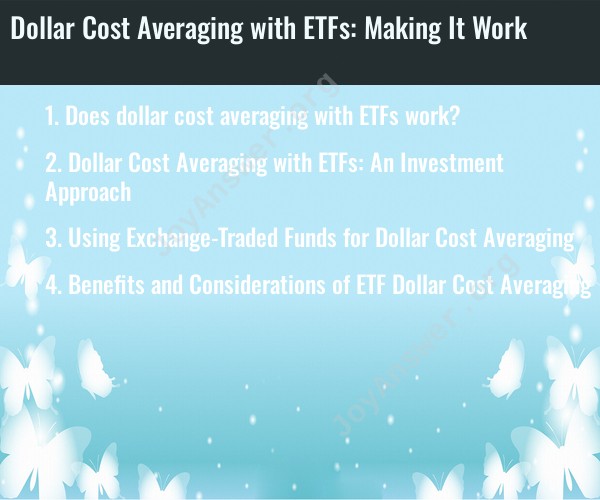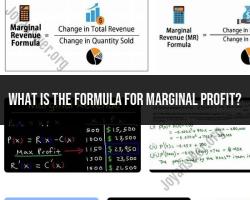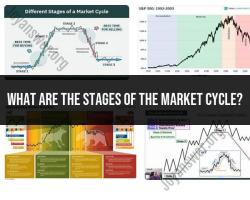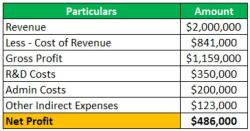Does dollar cost averaging with ETFs work?
Dollar cost averaging (DCA) is a well-established investment strategy, and it can be effectively used with Exchange-Traded Funds (ETFs) just as it can with individual stocks or other investment vehicles. The effectiveness of DCA with ETFs depends on several factors and can offer advantages for many investors. Here's how it can work effectively with ETFs:
Advantages of Dollar Cost Averaging with ETFs:
Diversification: ETFs are known for offering broad diversification within a single investment. DCA with ETFs allows you to spread your investments across various assets, sectors, or markets, reducing the risk associated with investing in individual stocks.
Liquidity: ETFs are traded on stock exchanges and provide high liquidity, making it easy to buy and sell shares at market prices. This liquidity is advantageous when implementing a DCA strategy, as it allows you to execute your investment plan without difficulty.
Low Costs: Many ETFs have lower expense ratios compared to traditional mutual funds. Lower costs can help maximize the impact of your investments over time, especially when employing a DCA strategy with regular contributions.
Transparency: ETFs typically disclose their holdings daily, enabling you to see the underlying assets in the fund. This transparency can be valuable when assessing the suitability of an ETF for your investment goals.
Flexibility: ETFs cover a wide range of asset classes, including equities, fixed income, commodities, and more. This provides you with flexibility to diversify your portfolio and tailor your DCA strategy to your specific investment objectives.
Considerations for Effective DCA with ETFs:
Asset Allocation: Choose ETFs that align with your desired asset allocation and risk tolerance. DCA should be part of an overall investment plan that reflects your financial goals.
Regular Contributions: To maximize the benefits of DCA, contribute a fixed amount of money at regular intervals, whether it's monthly, quarterly, or annually.
Investment Horizon: DCA is most effective when employed for a longer investment horizon. It can help reduce the impact of market volatility over time.
Rebalancing: Periodically review and rebalance your portfolio to maintain your desired asset allocation. Rebalancing may require selling some ETFs to bring your portfolio back in line with your allocation targets.
Risk Tolerance: Understand your risk tolerance and be prepared for market fluctuations. DCA does not eliminate market risk, but it can help mitigate its impact.
Fees and Expenses: Be aware of transaction costs associated with buying ETFs, such as brokerage fees and commissions. These costs can impact the effectiveness of DCA, so choose a platform with competitive pricing.
In summary, dollar cost averaging with ETFs can be an effective strategy for investors seeking diversification, cost efficiency, and liquidity. The strategy helps investors systematically invest in a diversified portfolio over time, reducing the need to time the market. However, it is essential to align your DCA approach with your long-term financial goals, regularly monitor your investments, and stay mindful of costs. Consulting with a financial advisor can also help you develop a DCA strategy that works for your specific financial situation and objectives.
Dollar Cost Averaging with ETFs: An Investment Approach
Dollar-cost averaging (DCA) is an investment strategy in which an investor invests a fixed amount of money at regular intervals, regardless of the price of the asset. This can be a good way to reduce the impact of volatility on the overall cost of your investments.
Exchange-traded funds (ETFs) are a type of security that tracks a basket of underlying assets, such as stocks, bonds, or commodities. ETFs are traded on exchanges like stocks, and they offer a number of benefits for investors, including diversification, low fees, and transparency.
Using ETFs for dollar-cost averaging can be a good way to invest in a diversified portfolio of assets without having to pick individual stocks or bonds. It is also a relatively low-cost way to invest, as many ETFs have expense ratios of 0.20% or less.
Using Exchange-Traded Funds for Dollar Cost Averaging
To use ETFs for dollar-cost averaging, you can simply set up a recurring investment with your broker. This will automatically invest a fixed amount of money into your chosen ETF at regular intervals, such as weekly, monthly, or quarterly.
When choosing an ETF for dollar-cost averaging, it is important to consider your investment goals and risk tolerance. You should also choose an ETF with a low expense ratio and a high tracking error. The tracking error measures how closely the ETF tracks its underlying index.
Benefits and Considerations of ETF Dollar Cost Averaging
Here are some of the benefits and considerations of using ETFs for dollar-cost averaging:
Benefits:
- Diversification: ETFs can provide exposure to a diversified basket of assets, which can help to reduce risk.
- Low fees: Many ETFs have low expense ratios, which can save you money on investment costs.
- Transparency: ETFs are transparent investment vehicles, and you can easily see what underlying assets they hold.
- Convenience: ETFs are traded on exchanges like stocks, making them easy to buy and sell.
Considerations:
- Tracking error: ETFs track their underlying index with varying degrees of accuracy. You should choose an ETF with a low tracking error.
- Liquidity: Some ETFs are more liquid than others. You should choose an ETF that has a high trading volume to ensure that you can buy and sell it easily.
- Tax implications: ETF investors may be subject to capital gains taxes when they sell their shares. You should consult with a tax advisor to understand the tax implications of investing in ETFs.
Overall, using ETFs for dollar-cost averaging can be a good way to invest in a diversified portfolio of assets without having to pick individual stocks or bonds. It is also a relatively low-cost and convenient way to invest. However, it is important to consider the tracking error and liquidity of ETFs before investing. You should also consult with a tax advisor to understand the tax implications of investing in ETFs.












